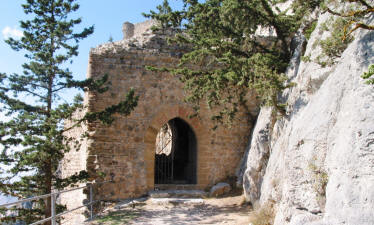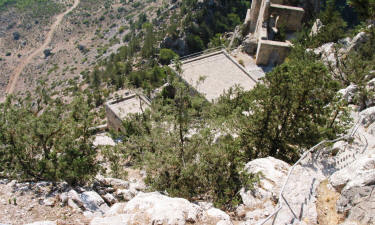Buffavento Castle,
Kyrenia, North Cyprus
 |
| Buffavento Castle |
At 955m above sea level, Buffavento castle stands the highest of the three crusader castles. However it is the least well preserved.
It probably originated as a Byzantine watch tower to guard against Arab raiders in the 10th century. It is said that the Byzantine king Isaac Commenos fled here when Richard the Lionheart invaded in 1191. The king's daughter surrendered herself and the castle to Richard, but Isaac Commenos continued his flight to Kantara. The castle was extended during the Lusignan rule, as were her sister castles of St Hilarion and Kantara. The Lusignan kings used the castle mainly as a political prison, known as the "Chateau du Lion". In particular, Peter I when reluctantly warned by his friend John Visconti of the queen's infidelity, repaid the favour by imprisoning and torturing him at Kyrenia, and later locking Visconti up at Buffavento to starve to death.
 |
| The Castle Gatehouse |
Like the other castles on the island, Buffavento is associated with a mystery queen. It is said that during the time of the Knights Templars, the empress Helena lived a solitary life in the castle, with only her dog as a companion. She developed leprosy, and this was passed on to the dog. Over time, she noticed that the skin on her dog had begun to heal. Following the dog one day, she saw that the animal was bathing in a spring far below the castle. Doing the same, she was cured of the disease. In gratitude, at the spot near the water source, she founded the monastery of Ayios Ioannis Chrysostomos.
By the 16th century, the castle had been dismantled by the Venetians in an attempt to protect themselves, as their focus moved to the strongholds along the coast at Kyrenia and Famagusta.
 |
| Looking Down |
From the seaward side, the castle is almost invisible, and the best long distance view is from the Nicosia side, where you can clearly see the remains of the castle bulging out from the top of the mountain. To visit, there are two possible routes. One is off the mountain pass on the Kyrenia-Famagusta road. An alternative route is through the village of Taskent, perhaps taking time to call in at the monastery of Panayia Absinthiotissa. Turn towards the mountains by the village store. Neither the monastery or the castle is signposted, but if you keep the giant Turkish Cypriot flag on your left in view, you will be on the right road. If coming from Nicosia, don't be tempted to look at your map and take the direct route via Gungor and Ayios Ioannis Chrysostomos. The road to both is through a military camp and is closed off to the general public. However, a new road has been built that bypasses the military area, and Buffavento is signposted from a roundabout near the original junction on the Lefkosa - Gazimagusa road.
Once you arrive, the climb to the first gateway takes around 30 minutes. Here you will see store rooms and dormitories opposite, with a water cistern underneath. From here, around 20 minutes will take you to the top level where there are remains of a few buildings and a ruined chapel. However, the climb is worth it for the views alone, taking in Kyrenia, Famagusta, Nicosia and, on a good day, the Troodos Mountains. You will also discover why the castle, who's name is translated to mean "Buffeted by winds", is so called!
The castle narrowly missed destruction in the North Cyprus fire of 1995 which destroyed 16,000 acres of forest around the castle itself.
Although there is not much to see compared to her sisters, Buffavento is a magical place that is exhilarating and gives a powerful sense of achievement for those who reached its lofty heights. And as you stand at the top, you can only wonder how anything got built up there in the first place.
See the location on Google Maps
Back to Kyrenia index.